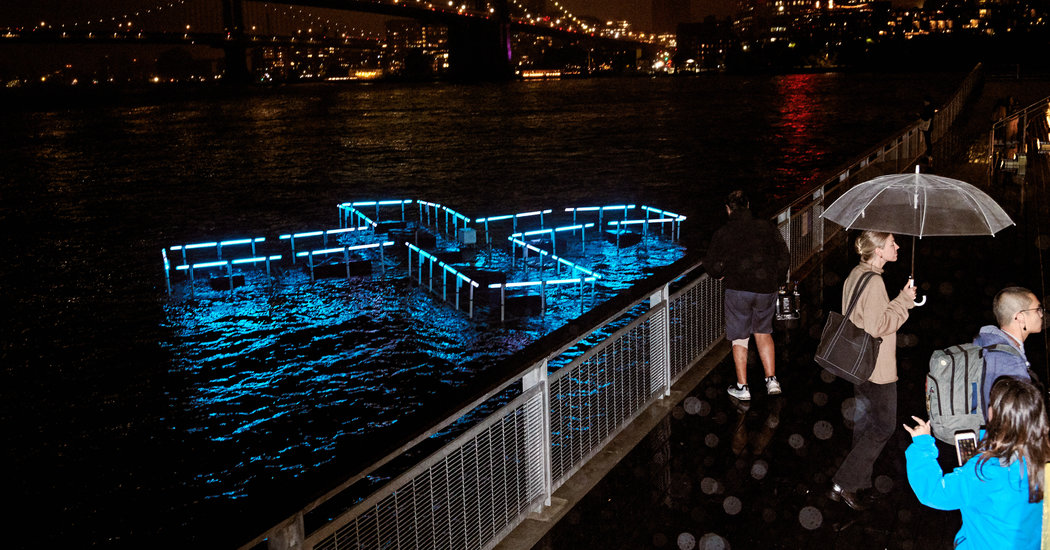
In 2011, media outlets began heralding a fantastical urban design project to be built in New York. A group of young designers and architects had dreamed up plans for a floating, self-filtering swimming pool on the East River, allowing New Yorkers to swim legally and safely in the polluted waterway for the first time in 70 years. The pool would be roughly Olympic size (164 feet by 164 feet) and shaped like a giant plus sign. It would be named Plus Pool, rendered as +POOL.
The idea captured people’s imagination. Time magazine named Plus Pool one of the 25 best inventions of 2013. It became a minor obsession of the real estate and urban design blog Curbed.com. A Kickstarter campaign that year raised over $273,000 from more than 3,000 backers for the designers to test water filtration materials.
But nine years after it was first conceived, Plus Pool remains an intriguing idea with no firm date to be constructed or opened.
“It’s been incredibly difficult, painful and exhausting,” said Archie Lee Coates IV, a partner at the New York-based design firm Playlab and one of Plus Pool’s masterminds, of the process to make it a reality.
Plus Pool grew out of a 2010 brainstorming session between Mr. Coates and his design partner, Jeff Franklin, and their friends, Dong-Ping Wong and Oana Stanescu, who at the time ran another design firm, Family New York. They lamented that New Yorkers are surrounded by water but live largely cut off from it.
“We suggested Plus Pool as a lark,” Mr. Coates said. “We had no idea about water quality, about how public parks were built, maintained and functioned.” (Perhaps he did not remember the famous scene in “Manhattan” when Woody Allen trails his hand in the water during a romantic boat ride and it comes out filthy.)
While Plus Pool may still be little more than a computer rendering, this week its founders unveiled a sculpture in the East River, titled “Plus Pool Light.” The sculpture, funded by the National Endowment of the Arts, Heineken and the Howard Hughes Corporation, will float for three months off Pier 17 in Manhattan’s Seaport District.
Made of aluminum and PVC and one-fourth the size of Plus Pool, the sculpture will change colors based on water conditions and animate based on other conditions, such as current direction and clarity. Teal means it’s safe to swim, pink means watch out for the sewage. The animating lights use data from sensors at the site and an algorithm developed by scientists at Columbia University’s Lamont-Doherty Earth Observatory.
“It’s about having people look at something beautiful and coming here if they want to learn more,” said Mr. Coates, looking out at the sculpture with Mr. Franklin one night earlier this week.
The saga of Plus Pool in many ways illustrates the difficulty of getting public design projects of any scale off the ground, given the prohibitive costs and red tape. It took more than a year working with the city simply to erect the sculpture. To build Plus Pool, the design team estimates a cost of $25 million, to be raised through a public-private partnership.
The project Plus Pool is most often compared to, the High Line, was officially conceived in 1999, and just completed its final leg this past June, 20 years later. Joshua David, a co-founder of Friends of the High Line, the nonprofit behind the elevated park, is on the board of Friends of Plus Pool (also a nonprofit) and believes it will “absolutely” happen.
“These are incredibly complex projects,” Mr. David said, adding that such creative reimagining of urban space “depends on political will. The speed at which you build that will can vary.”
Unlike the High Line, however, Plus Pool was conceived in the age of social media, which brought the project and its founders public attention before they were ready. “In 2011, people were going to the office address on our website thinking there was a pool there,” Mr. Coates recalled.
For the first several years, the team behind Plus Pool, with help from the engineering firm Arup and Columbia University scientists, tested water filtration systems to prove the idea was even feasible (they have filed patents for the filtration system itself and the hull of Plus Pool).
But the tide may be turning, so to speak. Last month, the city’s Economic Development Corporation issued a notice asking for proposals to be submitted by Nov. 1 for a floating self-filtering pool very much like the Plus Pool concept. The city said it was responding to interest from the community.
There was a time, back in the late 19th and early 20th centuries when New Yorkers enjoyed free public floating baths on the Hudson and East Rivers, an activity that ended when the Parks Department closed the last bathhouses, around 1940, because of the increasingly polluted water. In several modern cities, the waterways have already been reclaimed for swimming, most notably on the Seine in Paris, which opened public pools in 2017.
Mr. Coates and his colleagues no longer give a completion date for Plus Pool. But, nine years in, they haven’t lost their enthusiasm to make a reality what they dreamed up on a whim.
“There’s no other option than to keep going,” Mr. Coates said.







